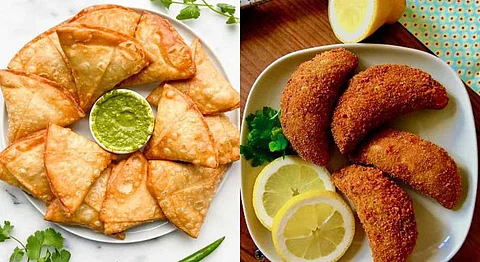
- HOMEGROWN WORLD
- #HGCREATORS
- #HGEXPLORE
- #HGVOICES
- #HGSHOP
- CAREERS
- ABOUT US
- CONTACT US

Dumplings are the quintessential cold-weather food, from being a student staple to the perfect post-work snack. The traditional definition of a dumpling is any kind of ground meat or vegetable, wrapped in a dough made of rice or wheat, and then steamed, fried, or boiled. They can also be filled with a sweet mixture. We most commonly know dumplings as momos, but almost every state in India has their own version of the dumpling that we have yet to try. Here’s an unfinished list of the kinds of dumplings everyone should try from across the country.
I. Momos
Momos are the undeniable king of dumplings, at least in India.
The Nepali snack is so versatile and has been adapted to suit all our tastes, whether they be more modern or purist in form. From regular chicken momos to schezwan momos, they can be found in five-star restaurants or the food stall invariably standing outside any college campus. With frozen momos getting more and more popular, you’re sure to find any kind of momo that you desire.
II. Modak
Those of us from Maharashtra will definitely know this sweet snack filling the shelves of our local mithai-walla during Ganesh Chaturthi, but this is a delicious variation on the dumpling to eat any time of the year. Stuffed with a mix of grated coconut and jaggery, then wrapped with a soft rice flour dough and then steamed. Also known as kadubu in Kannada, kudumu in Telugu, and kozhakattai in Tamil, this is a dumpling you will keep coming back to.
III. Rissóis
This little-known Portuguese snack is an Anglo-Indian dumpling native to Goa. Most commonly known as Rissóis de Camarão, they have a filling of creamy prawns that just melt in your mouth, with an outer covering made of flour, butter, and milk. Once the mixture is wrapped in the covering, it is then coated in breadcrumbs and fried. They puff up beautifully when fried, and we bet you can’t stop at just one. There’s also a less common cheese version for the vegetarians among us.
IV. Lavariya
Traditionally from Sri Lanka, this is very similar to the Tamil kozhakattai, lavariya is stuffed with caramelised coconut and jaggery, with moong dal or chana dal added occasionally. Then instead of being stuffed into a ball, the mixture is rolled into an elongated shape and wrapped with idiyappam, or string hoppers. Most popularly served as a tea-time snack in Sri Lanka, this is definitely one we want to try.
V. Pitha
From Bangladesh, vapa pitha or bhapa pitha is a rice cake stuffed with coconut and molasses, and then steamed or fried. Though it is sweet, it is served with beef, fish, or vegetable curry. Interestingly, this traditional winter dish is steamed on a cheesecloth that is tied over the mouth of a vessel filled with boiling water and then covered.
VI. Kheer Kadam
This might be a slight stretch, but Bengali kheer kadams are small rasgullas that are wrapped in a covering made of khoya or mawa, and then refrigerated until set. Chef Sanjeev Kapoor describes these kheer kadams as dumplings on his website and our mums’ favourite chef can’t be wrong, right? Just don’t forget to put in the namak, swaad anusar.
VII. Samosa
This is when all the momo-purists are really going to come at us, but what is a samosa, if not a fried dumpling? Remember the definition of a dumpling — any ground meat or vegetable or filling, wrapped in flour dough, and then fried. That is essentially a samosa. Though most samosas are slightly larger than your average dumpling, it still fits into the definition of a dumpling, and that’s why we think it qualifies on a technicality. Besides, this is the perfect excuse to go out and eat a samosa right now. Have we said samosa enough times to make you crave it? Here’s one more time for luck — samosa!
If you enjoyed reading this, we suggest you also read:
